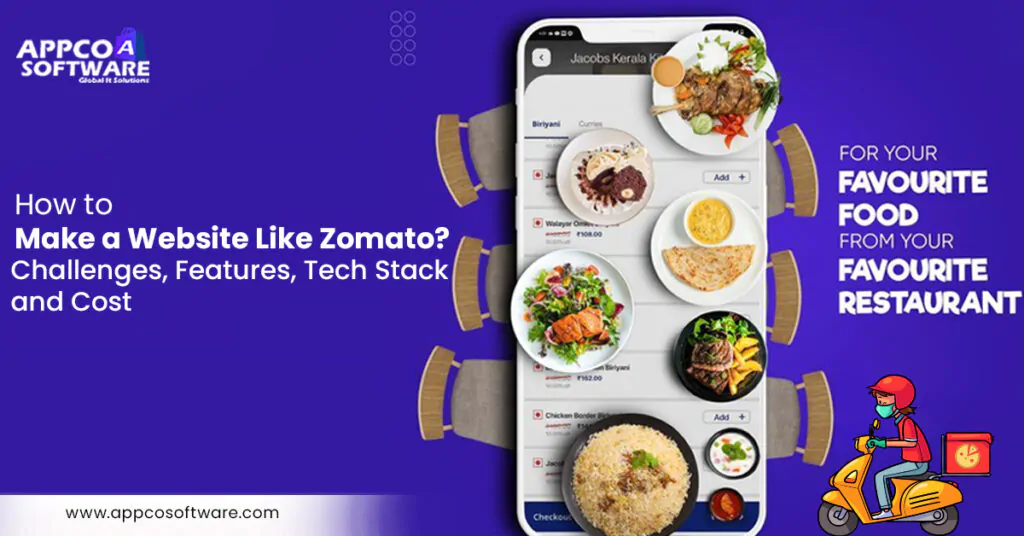Zomato started in 2008 as a simple restaurant listing site by two IIT Delhi grads. Today, as of September 2025, Zomato has a market cap of ₹1.952 trillion. According to the Companies Market Cap report, Zomato is the 980th most valuable company. Not just that, its parent company, Eternal Limited, now holds a market cap north of ₹3 lakh crore (that’s over USD 36 billion) thanks to its ownership of Zomato and Blinkit.
Zomato’s reach is massive. In FY 2023, it handled 647 million orders worth Rs 263.1 billion across 800 cities. And now in 2025, Zomato handled 853 million orders for its food delivery business. And this marked a 13% increase year-over-year.
For you, that’s a reminder that this kind of food and delivery business is growing. And if you’re considering entering the market, this is the ideal time for you. In fact, that’s why building a website like Zomato is not just a trend; it can be a lucrative business if done right. People love convenience. They want menus, ratings, deals, and quick deliveries, all in one place.
This guide, for example, takes you through the steps if you want to open a business like Zomato. Stay with us till the very last word of this article, you’re going to learn a lot of things.
Zomato Business Model Explained
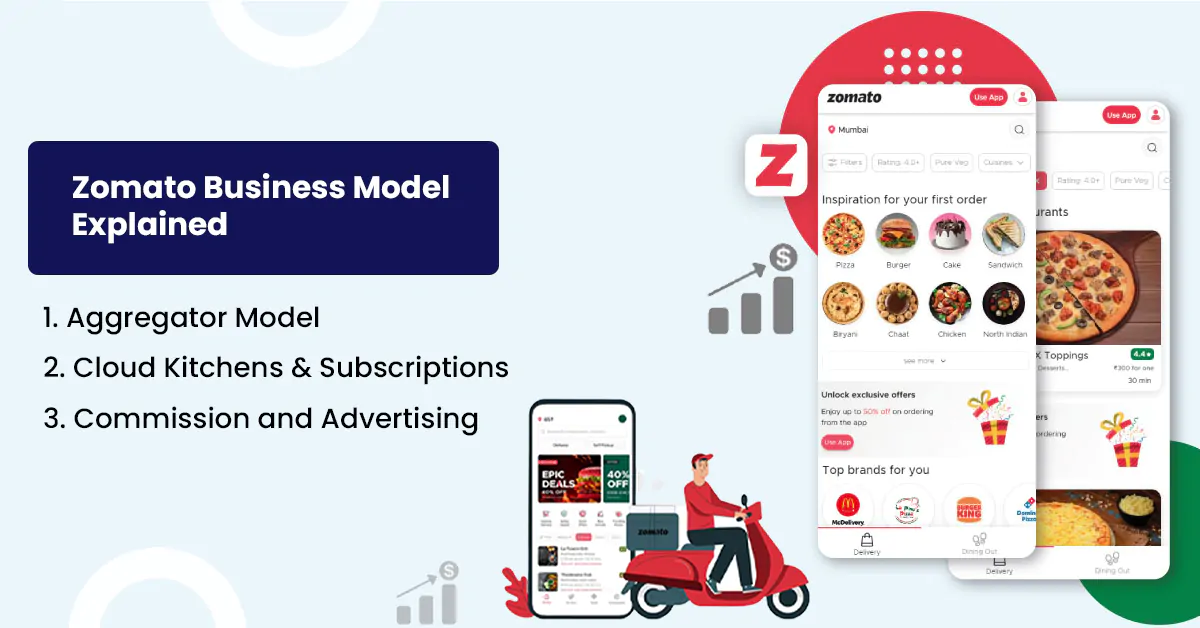
When you plan to make a website like Zomato, the first thing you should study is its business model. Zomato didn’t grow just because it delivered food; it grew because it built multiple income streams.
1. Aggregator Model
This is the classic model. You would be aware that restaurants list their menus on Zomato, and customers place orders through the app. Zomato acts as the bridge. Every order brings in a commission. If you want to build a food delivery website like Zomato, this model will be your starting point.
2. Cloud Kitchens & Subscriptions
Zomato doesn’t just stop with partner restaurants. It also works with cloud kitchens, restaurants that only deliver, but have no dine-in option. Plus, its subscription service (Zomato Gold/Pro) brings recurring revenue, for example. Customers pay monthly or yearly for benefits like free delivery and discounts.
3. Commission and Advertising
Zomato makes money from ads, too. Restaurants pay to appear at the top of the app when people search for food. You can understand it by taking an example of Google Ads, but inside Zomato. This mix of commissions and paid visibility gives the company an extra layer of income, which any smart web development company would tell you is crucial for scalability.
Core Features of a Website Like Zomato
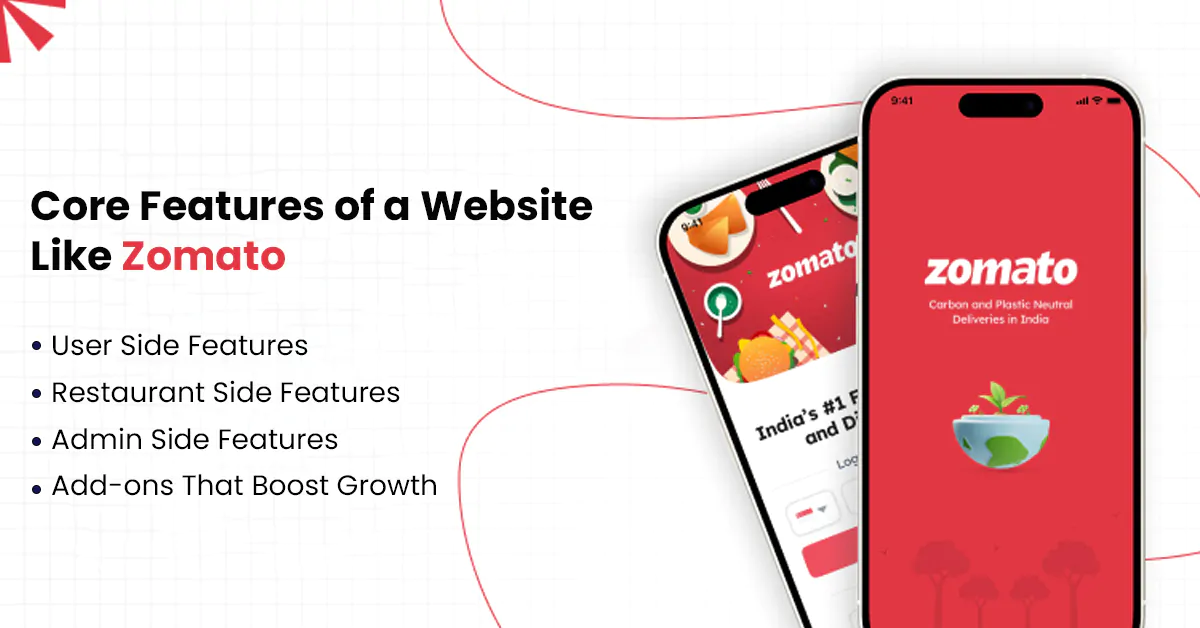
When you plan to make a website like Zomato, features are everything. Users don’t just want to order food, they want the full experience: from discovery to doorstep. Let’s break down the core features of a Zomato clone so you know exactly what to add.
1. User Side Features
This is where the customer journey starts. If you want to build an app like Zomato, then you must have to add a simple signup option. Your customers should be able to sign up from different options, such as Google, email, or even mobile OTP. And then, there should be a feature to search restaurants, filter by cuisine, price, or ratings, and place orders easily. Add secure payment gateways and real-time order tracking. Without live tracking, customers feel left out.
2. Restaurant Side Features
For restaurants, menu management is key. They should be able to upload food items, change prices, and mark items as “unavailable” in seconds. Order management is another must; restaurants need to accept, reject, or update orders quickly. And when it comes to building a successful store, don’t forget reviews; this is how trust is built.
3. Admin Side Features
As an admin, you would need a lot of controls to manage the cycle. You should have analytics to track daily orders, top restaurants, and customer behavior. Other than that, commission tracking ensures you know exactly how much you earn from each order. Plus, an easy dashboard to manage discounts, coupons, and offers keeps the platform competitive.
4. Add-ons That Boost Growth
To make your platform stand out, you can add loyalty programs for repeat customers, AI-based food recommendations, and a delivery partner app. Delivery partners need their own app to see orders, navigate, and get paid on time. This is where custom theme development also comes in, make sure the design matches your brand while keeping everything user-friendly.
Also Read – How to Build a Website Like Amazon?
Challenges in Building a Zomato-like Platform
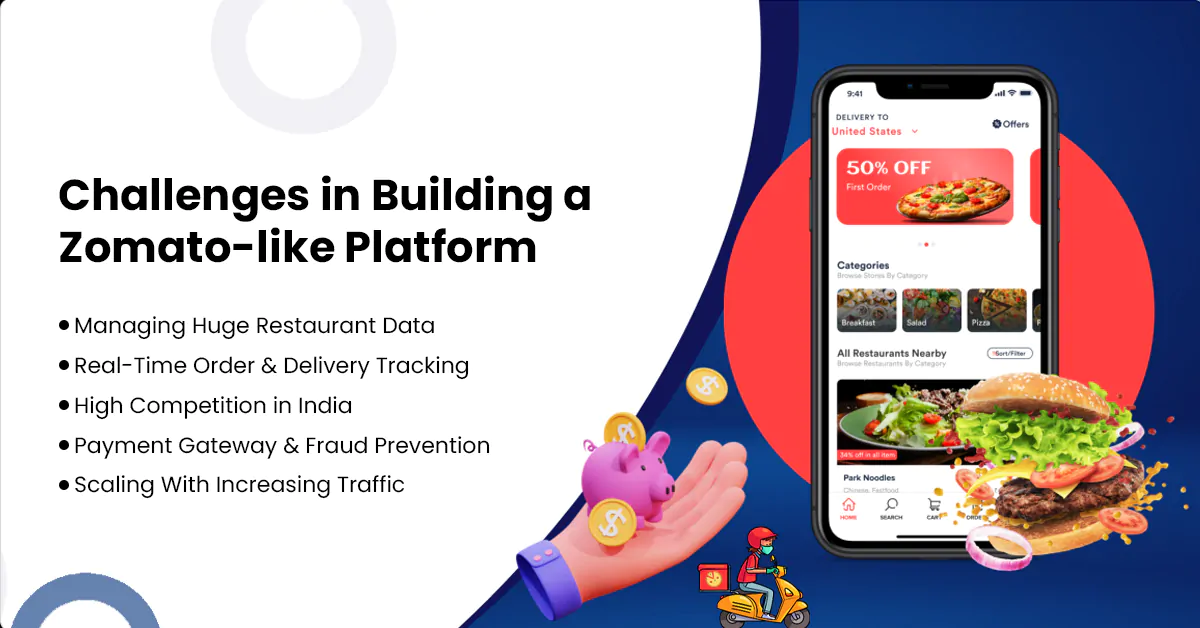
If you want to make a website like Zomato, you’re stepping into one of the most competitive markets in India. Food delivery is booming, but it’s not all easy money. There are hard challenges that you have to face from day one. But with the right plan and the right team (like working with an experienced eCommerce development company), these challenges can be managed.
1. Managing Huge Restaurant Data
You might know that Zomato works with thousands of restaurants across India. That means menus Zomato has a plethora of data. For example, addresses, photos, prices, offers, timings, and even hygiene ratings. Handling this data is no joke, for example.
- Every restaurant updates its menu almost daily, with new dishes, price changes, and unavailable items.
- Customers expect to see real-time updates. If the menu says “paneer butter masala available” but it’s out of stock, customers will feel cheated.
- Photos and reviews need moderation. Without checks, fake reviews or low-quality images can ruin the user experience.
A 2024 survey by Deloitte showed that 71% of online food customers leave negative feedback if the app shows outdated menus or wrong prices.
To handle this, you need a strong database setup with automation. An eCommerce development company with experience in food delivery website development can integrate APIs so that restaurants can directly update menus and availability in real-time.
2. Real-Time Order & Delivery Tracking
One big reason why Zomato and Swiggy dominate the market? Live tracking. Customers want to know where their food is, every single minute.
But real-time tracking is complex.
- GPS integration is expensive and needs constant server updates.
- Delivery partners move across crowded cities, and GPS sometimes lags.
- You need to build a separate app for delivery boys with maps, navigation, and status updates.
If tracking fails, customers lose trust. Imagine you ordered biryani, but the app shows “order preparing” for 40 minutes when the food is already out for delivery. It’s frustrating, right?
The challenge here is syncing three sides together: customer app, restaurant dashboard, and delivery partner app. Everything has to be connected in seconds.
3. High Competition in India
Food delivery is one of the fastest-growing sectors in India. In 2024, the India Online Food Ordering and Delivery Market was valued at USD 31.77 billion. With a CAGR of 28.17 percent, it is expected to reach USD 140.85 billion by 2030. That means you’re not alone in this race.
Big names like Zomato, Swiggy, Uber Eats (before it exited India), and even Blinkit are already fighting for customers. On top of that, local delivery startups are popping up in every city.
The biggest challenge is standing out. You can’t compete with Zomato on money or discounts. But you can focus on niche markets:
- Organic food delivery
- City-based hyperlocal deliveries
- College campus food services
- Only vegetarian or vegan food platforms
4. Payment Gateway & Fraud Prevention
Handling money online is another big challenge in India. Customers pay through UPI, cards, wallets, and even cash on delivery. And restaurants expect their share instantly. Also, delivery boys need payouts daily or weekly.
And here’s the dark side, fraud. Fake orders, stolen cards, payment gateway failures, and refund scams.
- According to a report by NDTV, cybercriminals caused digital payment fraud losses amounting to Rs. 23,000 crore in 2024, as flagged by RBI and other sources.
- A single gateway failure can cost you hundreds of orders in a single night.
To fix this issue, for example, you need trusted payment partners like Razorpay, PayU, or PhonePe. Along with this, AI-driven fraud detection tools can help block suspicious transactions in real time.
5. Scaling With Increasing Traffic
What happens when your platform grows from 1,000 orders a day to 100,000? Your servers can crash. Your app can hang. Your website can slow down.
Scaling is not just about adding more servers. It’s about:
- Cloud hosting with auto-scaling (AWS, Google Cloud).
- Load balancing so no server is overloaded.
- Optimizing the code so that pages don’t take forever to load.
- Regular speed audits and testing.
A study by Google shows that 53% of users leave a mobile site if it takes more than 3 seconds to load. For a food delivery platform, even 1 extra second can cost you thousands of customers.
This is why you need experts who know food delivery website development inside out. A skilled web development company can prepare your platform for scale, so you don’t end up crashing during peak hours like lunch or dinner.
Tech Stack for a Food Delivery Website Like Zomato
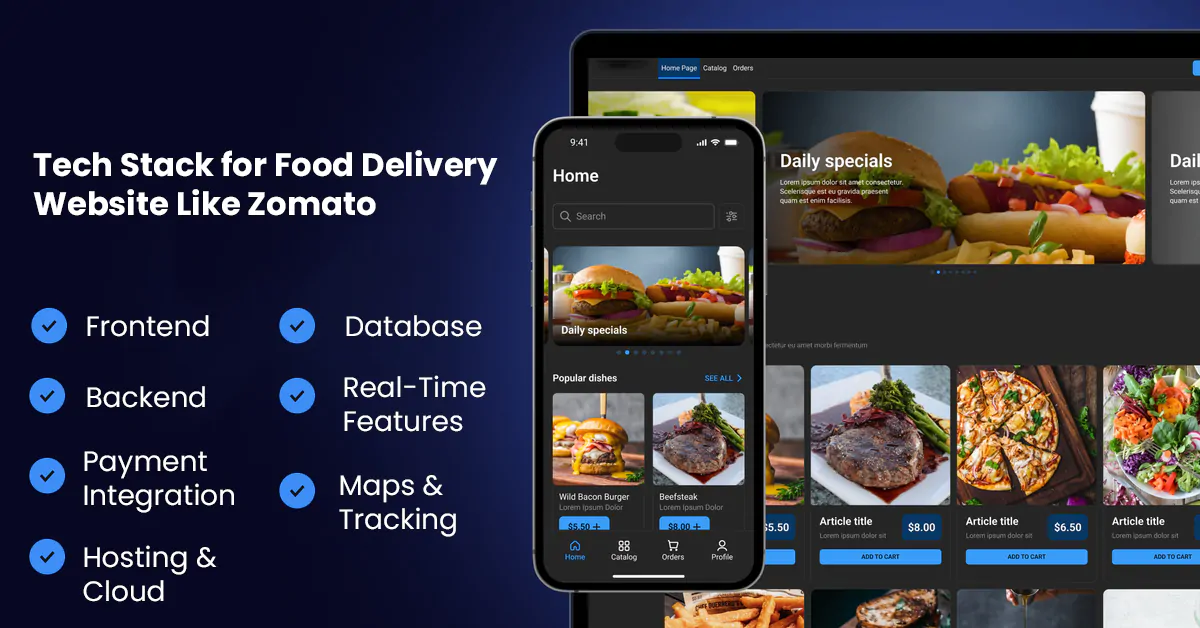
When you want to make a website like Zomato, design and features are only half the game. One of the very basic, at the same time, most advanced things is the tech stack. Without the right technology, for example, your site will crash, lag, or simply fail to handle orders at scale.
So let’s learn what tools and frameworks you actually need for food delivery website development.
1. Frontend
The frontend is the face of your website. It’s what users click, scroll, and interact with. If it’s slow or clunky, people leave before even placing an order.
- React.js – Fast, flexible, and perfect for building interactive food delivery apps.
- Angular – Great for complex platforms, but can be heavy.
- Vue.js – Lightweight and simple to manage, especially for startups.
2. Backend
The backend is the brain of your platform, for example. This is where all the data is stored, orders are processed, and payments are verified.
- Node.js – Popular for real-time apps like delivery tracking.
- Django – Strong for security-heavy apps like food delivery.
- Ruby on Rails – Great for quick development if you want to launch fast.
Without a solid backend, your app can’t handle thousands of restaurants and millions of orders.
3. Database
- MongoDB – Flexible and perfect for big platforms.
- PostgreSQL – Reliable for handling large amounts of structured data.
- MySQL – A proven choice, especially for scaling websites.
A poorly set-up database can cause delays in loading menus, wrong order details, or even lost payments.
4. Real-Time Features
Live order tracking is a must. Without real-time updates, customers will spam your support asking, “Where’s my food?”
- WebSockets – Allows instant communication between customers, restaurants, and delivery partners.
- Firebase – Google’s real-time database, great for push notifications and live updates.
Example: When a delivery boy picks up food, the app updates instantly for the customer. No waiting. No refreshing.
5. Payment Integration
- Razorpay – Most popular in India for UPI, cards, and wallets.
- Stripe – International standard, great if you plan global expansion.
- PayPal – Still widely trusted for cross-border payments.
A failed payment can cost you both revenue and reputation. That’s why most food delivery website development projects integrate at least two payment gateways for backup.
6. Hosting & Cloud
If you don’t want your platform to crash at 8 pm during dinner rush, you need strong hosting.
- AWS (Amazon Web Services) – Scalable, trusted by big players.
- Google Cloud – Another reliable option with AI-based add-ons.
7. Maps & Tracking
Without proper maps, your delivery partners will get lost, and orders will be delayed. And most importantly, your customers will stop trusting you.
- Google Maps API – The most accurate, widely used worldwide.
- Mapbox – Good alternative with custom features and detailed routes.
Cost to Build a Website Like Zomato
When building a website like Zomato, the first thing you will think about is cost. And the truth is, the cost depends on what exactly you want to build. The features, design, tech stack, and even whether you go with a custom theme development or a ready-made Zomato clone website development script, all these factors decide your budget.
Here’s a clear breakdown for you:
- Basic Website (Web only):
If you just want a simple food delivery website with restaurant listings, orders, and payments, you can expect the cost to be between $10,000 – $15,000 (₹8–12 Lakh). This is good if you’re starting small with limited cities. - Full Website + Mobile Apps (Android & iOS):
For a complete package with customer app, restaurant app, delivery partner app, and admin dashboard, the cost usually goes up to $25,000 – $50,000 (₹20–40 Lakh). This is the range most startups and growing businesses look at when they want to compete in the food delivery market. - Ongoing Maintenance & Marketing:
Building the platform is only step one. You also need to keep it running smoothly with regular updates, bug fixes, and Shopify speed optimization services (if you choose Shopify for your setup). On top of that, you’ll have to spend on marketing and SEO. Hiring a Shopify SEO expert or a web development company that also provides marketing support will help you rank and bring in orders faster.
How to Get Started
Alright, so you know the cost, the features, and most importantly, the challenges. But where do you begin? Here’s the simple path you can follow if you want to make a website like Zomato:
1. Pick Your Business Model:
Don’t jump into development without a plan. Decide how you want to run things. Do you want to list restaurants like Zomato does? Or maybe you want to run your own kitchen and deliver directly? This single choice will decide everything else, from the money you spend to the features you need.
2. Choose the Right Development Partner:
This is where most people make the mistake, for example. You can’t rely on random freelancers for a project this big. You need a proper web development company that has already worked on food delivery website development. A good team saves you months of trial and error.
3. Build a Minimum Viable Product (MVP):
You should not aim for a giant app on day one. Instead, you should start with the basics like user signup, restaurant listings, simple ordering, and secure payments. Once people start using your application on different operating systems, you’ll know what’s missing and what to fix.
4. Grow Step by Step:
After your MVP works fine, you can go further and add the extra features. And those features could be anything like real-time tracking, AI suggestions, loyalty points, and faster delivery optimization.
🚀 Build Your Own Zomato-Like Website
From features to cost planning, we’ll help you overcome challenges and launch a food delivery platform with confidence.
Final Thoughts
Food delivery is no longer just a trend in India; it’s a lifestyle. And with all those numbers we have mentioned in the article, you are pretty much sure about the real growth. From students in hostels to families in metro cities, everyone orders online because it saves time and gives convenience. With millions of orders every month and new users joining in daily, the food-tech space is only going to get bigger.
For you, this is the best business idea. If you’ve been planning to make a website like Zomato, now is the time to do it. It does not matter if you want a simple platform to test the waters or a full setup with apps and advanced features; the opportunity is right in front of you. And you don’t have to do it alone. A skilled team that understands Zomato clone website development can handle the design, tech, payments, and scaling while you focus on running the business.
Having said that, if you are looking to build your own food delivery platform like Zomato, we are here. Appco Software has been around for more than 13 years now and has delivered 5000+ successful projects. In order to contact us,you can drop us a message or call us, and one of our experts will contact you shortly.
Make a Website Like Zomato FAQs
1. How much does it cost to build a website like Zomato?
It depends. For example, a basic food delivery website can cost around ₹8–12 Lakh. If you also want mobile apps, the cost goes up to ₹20–40 Lakh.
2. How long does it take to develop a Zomato-like platform?
On average, it takes 4–6 months to build a food delivery website with apps. The timeline also depends on the custom features you want to add.
3. Do I need mobile apps or is just a website enough?
A website alone is a good option for testing. But if you want to grow like Zomato, then in this case, you should launch both Android and iOS apps along with the website.
4. Can I start small with fewer features?
Yes, you can begin with an MVP (basic version). Add core features like search, orders, and payments first. Later, you can scale with new features.
5. What features are must-haves for a Zomato clone?
For example, you need user signup, restaurant listings, order management, secure payments, and real-time tracking. And extra features like loyalty points and AI suggestions can be added later.
6. Is it better to use a clone script or custom development?
Well, clone scripts are cheaper but limited. And custom development costs more, but gives you full control and better scalability.
7. Do I need a big team to run a food delivery platform?
Not in the beginning. You just need a reliable web development company to build it, and a small team to handle orders and support.
8. Can Appco Software help me build a platform like Zomato?
Yes. At Appco Software, we offer food delivery website development with apps, speed optimization, SEO, and long-term support to help you scale fast.

